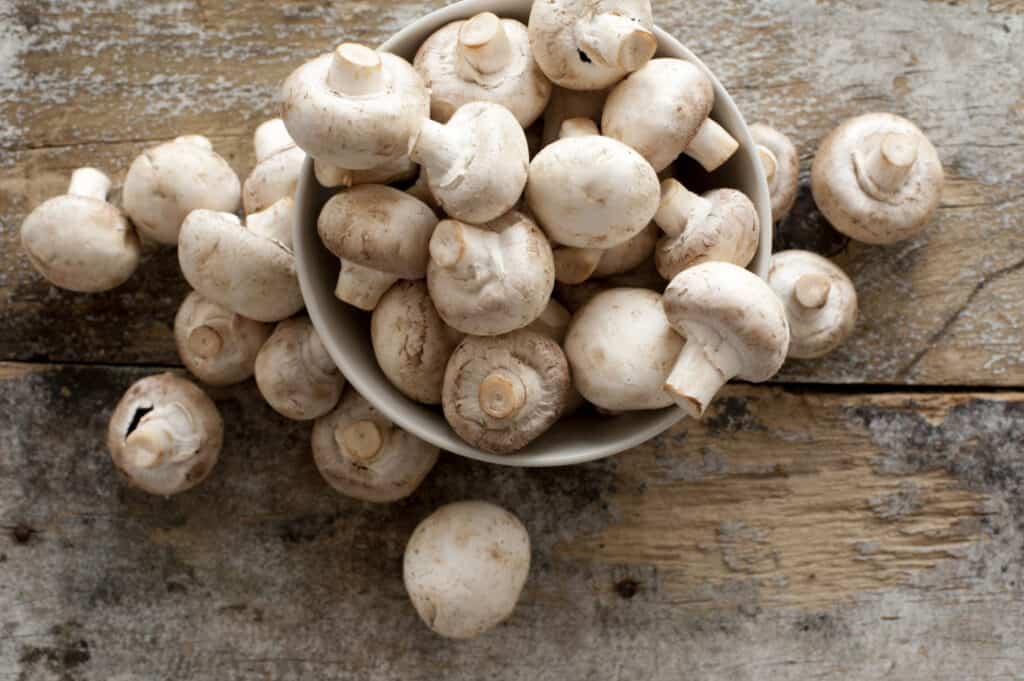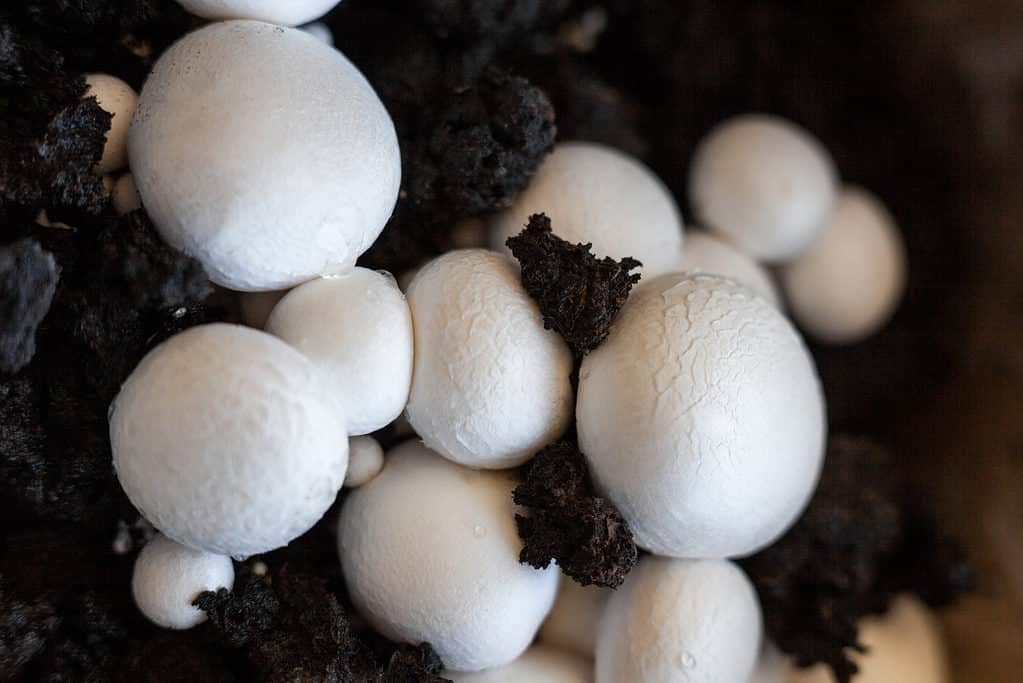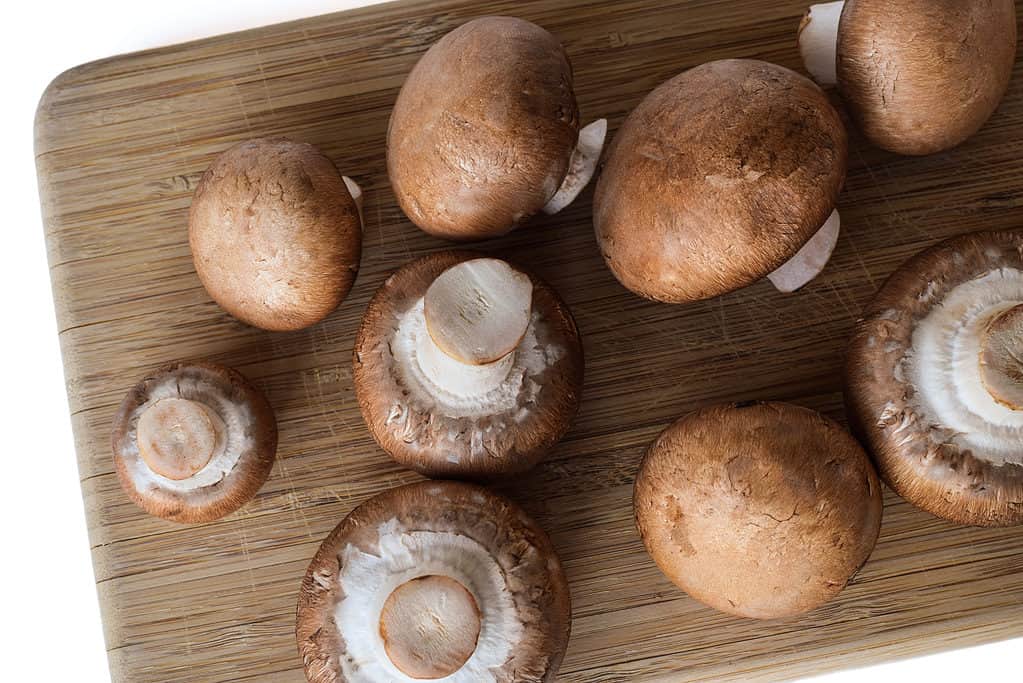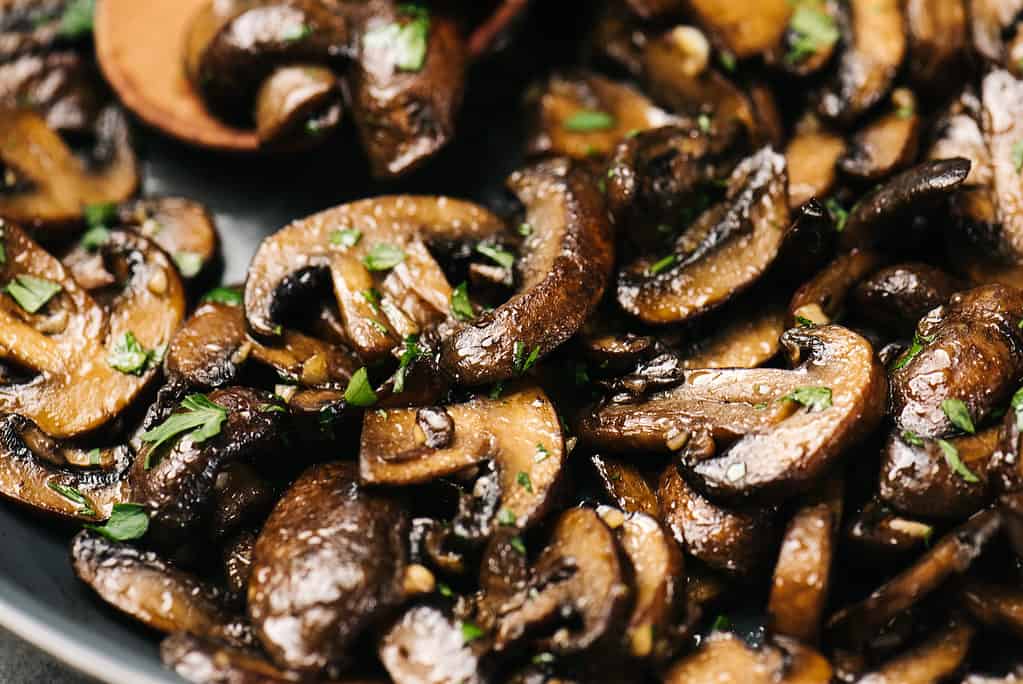When you are shopping for mushrooms in the grocery store or at your local farmers market, you may be overwhelmed by the many different-looking mushrooms. Which is which species and when should you use each one? When you compare button mushrooms and cremini mushrooms, they can look quite different from each other. However, they are actually members of the same species of edible fungus! Though they go by different names, rather than being two different species, they are actually the same species harvested at different stages of maturity. Button mushrooms are at the youngest stage of maturity, while cremini mushrooms are slightly older. However, this small difference does have an impact – it changes their appearance, taste, and how people use them in several different ways! Let’s dive in to explore some of these differences now.
Comparing Button Mushrooms vs. Cremini Mushrooms
First, here are some of the key details about button mushrooms and cremini mushrooms:
- Scientific name: Agaricus bisporus
- Genus: Agaricus
- Family: Agaricaceae
- Order: Agaricales
- Class: Agaricomycetes
- Division: Basidiomycota
- Kingdom: Fungi
- Geography of origin: Asia, Europe, and North America
- Countries of major cultivation: United States, Canada, India, Indonesia, Ireland, Korea, Netherlands, Poland, Taiwan
| Characteristic | Button Mushrooms | Cremini Mushrooms |
|---|---|---|
| Common Name | Button mushroom, white button mushroom, white mushroom | Baby bella mushroom, brown mushroom, chestnut mushroom, cremini mushroom, crimini mushroom, Italian brown mushroom, Roman brown mushroom, Swiss brown mushroom |
| Description of Fungus | When cultivators harvest Agaricus bisporus at its youngest stage of maturity, they are called “button mushrooms” or one of the other names listed above. At this early stage, they are small, white, and have a mild flavor. They are typically harvested when their caps reach between half an inch and 3 inches in diameter. | When cultivators harvest Agaricus bisporus at a middle stage of development, still immature but with several weeks of growth more than button mushrooms (approximately 40 days), the mushrooms are called “cremini mushrooms” or one of the other names listed above. At this stage, their color can range from tan to dark brown. They have an earthy flavor, and typically have caps that are between 1 and 3 inches across. |
| Harvesting Period | Cultivators harvest button mushrooms at as early as seven to 14 days of growing, after the initial sprouting of the mycelium. | Cultivators harvest cremini mushrooms after several weeks (approximately 40 days) of growth. |
Descriptions of Button and Cremini Mushrooms
Button mushrooms and cremini mushrooms are both the Agaricus bisporus species. This is one of the most popular species of edible fungus in the world. The species is within the Agaricus genus, which is one of many genera in the Agaricaceae family. This family contains several edible species, including some of the most commonly-cultivated mushrooms and wild-growing edible mushrooms. Button mushrooms, cremini mushrooms, and portobello mushrooms are all names for Agaricus bisporus. Their differences are from the species being harvested at differing stages of maturity. The mushrooms sold at these three stages are among the most popular mushrooms for human consumption. Their popularity has made Agaricus bisporus the most widely-sold edible fungus in the United States.
Though Agaricus bisporus grows in the wild in moist, grassy areas, it is also widely cultivated across the globe. It grows naturally in environments such as pastures, which have grassy, damp, fertile soil. Cultivators recreate this environment, which is rich in animal manure, using compost and added water.
Description of Button Mushrooms
When harvested at its youngest stage of maturity, Agaricus bisporus is known as a “button mushroom.” At this point, the caps of the button mushrooms can be between 1 and 3 inches across. However, many are smaller! It is common for button mushrooms to be harvested when as tiny as only half an inch in diameter. They are white or cream-colored and have a mild flavor and tender, slightly spongy texture. Button mushrooms go by several other names and are also commonly known as “white button mushrooms” or “white mushrooms.”

When cultivators harvest
Agaricus bisporusat its youngest stage of maturity, they are called button mushrooms.
©Stephen Gibson/Shutterstock.com
Description of Cremini Mushrooms
When harvested at an older, but still immature stage of growth, Agaricus bisporus is known as a “cremini mushroom.” At this point, the mushrooms have been growing for several weeks (approximately 40 days). They are typically larger than the average button mushroom. Their texture can also be firmer, as they lose water content as they mature. Cremini mushrooms caps will have begun to turn from white to brown. Their caps range in color from light to dark brown color on the top. Their flavor has also developed more and will taste stronger and more earthy as a result. Cremini mushrooms go by many other names. They are also known as “baby bella mushrooms,” “brown mushrooms,” “chestnut mushrooms,” “Italian brown mushrooms,” “Roman brown mushrooms,” and “Swiss brown mushrooms.”

When harvested at an older, but still immature stage of growth,
Agaricus bisporusis known as a cremini mushroom.
©Svetlana Lukienko/Shutterstock.com
Key Differences
Because button mushrooms and cremini mushrooms are the same species of fungus simply harvested at different time periods, they have a lot in common. Their history is similar. They undergo the same process of cultivation for most of their growth. Additionally, they appear in some of the same recipes. However, there are a few ways in which the two are distinct – in their appearance, taste, and use. Let’s discuss these qualities now.
Button Mushrooms vs. Cremini Mushrooms: History
Mushrooms have been harvested by humans from the wild for thousands of years. Historians can also trace the history of mushroom cultivation back centuries. However, the cultivation of Agaricus bisporus in Europe grew immensely in the 1500s and early 1600s. At this time, commercial production became much more common and eating Agaricus bisporus gained popularity, even among royals. Some historians report a rise in popularity of mushrooms in French cooking at the time of Louis XIV. This influenced culinary trends and may have even shaped our consumption of white button mushrooms to this day.
Agaricus bisporus can grow in the wild in the cooler climates of Asia, Europe, and North America. However, these continents have also been the site of major cultivation for hundreds of years. However, with technology and global trade, these mushrooms have become popular across the world. In the 21st century, countries including the United States and Canada, parts of western Europe (Ireland, the Netherlands, and Poland), and many countries in Asia (India, Korea, Indonesia, and Taiwan) produce and consume both button and cremini mushrooms.
Both button and cremini mushrooms are widely-consumed. However, button mushrooms far surpass creminis and are one of the most popular ways to consume Agaricus bisporus. In fact, button mushrooms alone represent the majority of all mushroom consumption within the United States.

Button mushrooms far surpass creminis and are one of the most popular ways to consume
Agaricus bisporus.
©rootstock/Shutterstock.com
Button Mushrooms vs. Cremini Mushrooms: Appearance
You can recognize button mushrooms compared to cremini mushrooms and their older counterpart, the portobello, by their white color. They are white, cream, or sometimes pale tan in color on their cap and stem. The cap is smooth and round, curling under at the edges to hide light brown gills. Their stems are short and white. Button mushrooms have a firm but sponge-like texture.
As the mushroom continues to mature, it develops a brown or tan cap, the gills emerge from under the edges of the cap and darken into a darker brown, and the cap grows in size. Cremini mushrooms have caps that range in color from pale tan to dark brown, though the stems are still short and white. The texture is similar to that of a button mushroom, though slightly more firm. Cremini mushrooms are harvested while still small, typically when their caps are between 1 and 3 inches across.

Cremini mushrooms have caps that range in color from pale tan to dark brown, though the stems are still short and white.
©iStock.com/JulieAlexK
Button Mushrooms vs. Cremini: Growing Conditions
The Agaricus bisporus species grows across the world in moist, grassy areas such as cow pastures, where there is damp soil rich in nitrogen and grassy conditions. If you would like to cultivate them at home, you can replicate this environment by mixing compost with manure and keeping the soil moist and warm, ideally at around 70 degrees Fahrenheit. This will provide the ideal conditions for them to spawn and develop a mycelium web.
Try to maintain these temperatures and don’t let the conditions get too hot, as that can kill the spores. To ensure that the soil stays moist, use a spray bottle to mist the cultivation area. You can expect that after several weeks, if you are successful, a web of mycelium will develop across the top of your manure or a compost and manure mixture. Several weeks later, the mushrooms will begin to grow. Keep them moist and maintain your soil conditions for a few more weeks. When you are ready to harvest, twist them out of the dirt.
At this point, you will learn one of the reasons why button mushrooms are so popular compared to cremini mushrooms. Button mushrooms are harvested sooner, sometimes only 14 days after sprouting! In contrast, you will need to wait several more weeks to harvest your cremini mushroom, and even longer if you want to see it develop into a portobello. When grown on a large scale, cremini and portobello mushrooms take more time and resources to cultivate than button mushrooms. This is part of the reason why you may see that they often cost more to buy at a store compared to button mushrooms. However, if you can wait, you may enjoy the more robust flavor of a cremini mushroom.

When grown on a large scale, cremini and portobello mushrooms take more time and resources to cultivate than button mushrooms.
©ArliftAtoz2205/Shutterstock.com
Button Mushrooms vs. Baby Bella Mushrooms: Taste
Compared to the other two stages of Agaricus bisporus harvesting, button mushrooms are the mildest in flavor. They have a pleasant chewy texture that is tender and mild. Button mushrooms are also very easy to prepare and cook because every part of a button mushroom is edible, including the cap, gills, and stem! They also taste good either raw, cooked, or dehydrated and added into soups or stews to rehydrate. Because they are so mild in taste, you will often find that recipes combine button mushrooms with other strong spices or even other mushroom species, which bring a stronger flavor.
In comparison, cremini mushrooms have a slightly firmer texture. Their loss of water as they mature means that they develop a slightly stronger, earthier flavor. They are not as tender as button mushrooms, which makes them more suitable for use in stews or soups and allows them to bring a savory flavor to a broth or sauteed stir fry. You will also notice that as they mature, the stems and gills become less appetizing. Though they remain edible, as the mushroom matures, the stem will become woodier and less tender. The brown gills may also be removed, depending on the preference of the cook, so that they do not add an unpleasant brown color to a dish.
Button Mushrooms vs. Cremini Mushrooms: Uses
Preparation
Are you learning how to cook with mushrooms for the first time? If so, either button or cremini mushrooms are a great choice for you to try! When you get started, you may want to take a different tactic than what you would do for vegetables or fruit. Rather than washing your mushrooms with water, cooks recommend using a brush or damp cloth. Use this to gently wipe away dirt or debris. The sponge-like mushrooms can become water-saturated and mushy if they are washed in water, so preserve the texture by avoiding water altogether! However, if not washing them makes you nervous, go ahead and rinse the mushrooms and use a paper towel or cloth to pat them dry.
You can then trim the end of the stems before cooking or incorporating the mushrooms into a recipe raw. Button mushrooms can be eaten whole or sliced into smaller pieces. Cremini mushrooms are also entirely edible, though if you find the gills to be unsightly, you can go ahead and scoop them out.
Cooking
If you would like to try a recipe with button mushrooms for the first time, look to add them to a stir fry, fried rice, salad, pizza, or pasta dish! You can also use a combination of button and cremini mushrooms to have lots of texture while getting a mix of mild and earthy flavor. Cremini mushrooms are a better choice to add to a soup, sauce, or stew, or to sauté and add as a topping.
Mushrooms are on the rise! In recent years, mushrooms have become more popular as a health “superfood.” Particularly among vegans and vegetarians, mushrooms have gained popularity as a meat substitute. Because they have a robust flavor and can have a meat-like texture, cremini and portobello mushrooms in particular are popular “meat replacement” options. Mushrooms are rich in vitamins and are extremely protein-dense. This makes them a nutritious and delicious option as a main dish or simply as an addition to other recipes.

Cremini mushrooms are a better choice to add to a soup, sauce, or stew, or to sauté and add as a topping.
©Cavan-Images/Shutterstock.com
Storage
Both button and cremini mushrooms should be stored in the refrigerator and can be kept for approximately 1 to 1.5 weeks, depending on the conditions. If you leave them too long, they will start to become slimy and will develop ugly spots. To help them last the longest, try covering them with a cloth or keeping the mushrooms in a brown paper bag. Avoid using plastic bags, which can trap moisture that will make them turn soft and slimy faster than they might otherwise.
In Summary
This article compares button mushrooms and cremini mushrooms. As we discussed, these are simply two names for the fungus Agaricus bisporus. The major differences between the two come from being harvested at two different stages of maturity. When they are at their youngest, they are tender, mild, white, and called “button mushrooms.” When they are slightly more mature and flavorful, they are tan to dark brown in color, earthy in flavor, and called “cremini mushrooms.” Though both button and cremini mushrooms are the same species, it’s incredible what just a few additional weeks of growth can do! Time significantly impacts their appearance and taste. However, both are delicious and can add wonderful flavor and texture to many different recipes. Why not try cooking with button or cremini mushrooms today?
The photo featured at the top of this post is ©
The information presented on or through the Website is made available solely for general informational purposes. We do not warrant the accuracy, completeness, or usefulness of this information. Any reliance you place on such information is strictly at your own risk. We disclaim all liability and responsibility arising from any reliance placed on such materials by you or any other visitor to the Website, or by anyone who may be informed of any of its contents. None of the statements or claims on the Website should be taken as medical advice, health advice, or as confirmation that a plant, fungus, or other item is safe for consumption or will provide any health benefits. Anyone considering the health benefits of particular plant, fungus, or other item should first consult with a doctor or other medical professional. The statements made within this Website have not been evaluated by the Food and Drug Administration. These statements are not intended to diagnose, treat, cure or prevent any disease.
Sources
- PBS, Available here: https://www.pbs.org/food/the-history-kitchen/edible-mushrooms/
- Cornell Extension, Available here: https://ecommons.cornell.edu/handle/1813/9490
- Penn State Extension, Available here: https://extension.psu.edu/mushrooms
- NC State Extension, Available here: https://newcropsorganics.ces.ncsu.edu/specialty-crops/mushrooms/
Thank you for reading! Have some feedback for us? Contact the AZ Animals editorial team.






